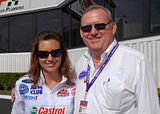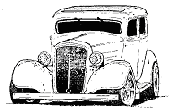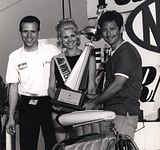Dick Wells (1934-2010)
A member of both the NHRA board of directors and the NHRA Wally Parks Museum board of directors, SEMA Industry Hall of Famer Wells began his long and storied career in motorsports as National DRAGSTER’s first editor in 1960.
“Dick loved the NHRA and everything about drag racing and the world of performance,” said Dallas Gardner, NHRA chairman of the board. “His passion led him to a lifetime of contribution that, simply put, made things better. His efforts and influence touched everyone. He was a great part of the leadership that saw the sport grow to what it has become today. We will miss him for his participation, but we will miss him more as a friend.”
As the original editor of National DRAGSTER, Wells laid the foundation for what would become drag racing’s most famous publication. He joined the NHRA Board of Directors in 1979 and has been an important force behind the scenes for the world’s largest motorsports sanctioning body since then.
“NHRA lost one of its most loyal and trusted advisors and friends in Dick Wells,” said Tom Compton, president, NHRA. “He was an integral part of NHRA in the early days and has been a guiding force for NHRA ever since. Dick loved NHRA and was an ambassador like no other for the sport. On behalf of his NHRA family, we send our heartfelt condolences to his family and friends. He will be greatly missed.”
After his tenure at National DRAGSTER, the hot-rodder from Lincoln, Nebraska, later moved on to editorial positions at Hot Rod and earned the title of executive editor at Motor Trend. As Petersen Publishing Company’s director of special events, Wells produced what many believe to be his greatest contribution to the automotive industry: the first SEMA Show in 1967 at Dodgers Stadium in Los Angeles.
Wells, who also began the Street Rod Nationals and was the first active president of the National Street Rod Association, is credited with the massive street rod movement in the U.S. In 2007, he retired from the position of vice president of corporate projects at SEMA, where he also served as executive director in the 1970s.
He has been honored many times over for contributions to the automotive industry. He was named SEMA Person of the Year in 1977 and was inducted into the SEMA Industry Hall of Fame in 1993. He was presented the International Specialty Car Association (ISCA) Founder’s Award in 1994, the Street Rod Marketing Alliance Industry Recognition Award in 1996, and was among those honored with the NHRA Pioneers Award in 2001. Last year he was inducted into the Nebraska Auto Racing Hall of Fame.
Dick Wells: In his own words
NHRA board member Dick Wells, who died Jan. 18, was National DRAGSTER's first editor and a lifelong wordsmith. In March 2007, he authored this entertaining and interesting biography that tells of his amazing career in the world of motorsports. Although written in the third-person, it's genuine Dick Wells prose.
His father had mixed emotions about Dick’s interest in cars. The Chevy was polished and waxed so often that the paint was wearing through to the primer in many spots, but after an experience with his pal, he chose not to repaint it.
Here’s what happened: His high school friend, Dale, also had 1936 Chevy, which he decided to paint. The two 16-year-olds began on a Saturday morning, when Dale’s parents left home to go shopping. Dale got out his mother’s all-new vacuum cleaner with a spray-paint attachment, and they proceeded to paint the Chevy a bright blue color, outdoors on a brisk autumn day. Having no knowledge of painting, and indeed masking, the Chevy took on an odd look with blue wheels and tires, and small openings in all of the windows; the finish was akin to thick sandpaper, filled with the remnants of twigs and leaves. Dick told Dale, “The blue tires don’t look all THAT bad, do they?” Dale was forlorn; he should have been frightened. Painting the car outdoors meant that the vacuum cleaner sucked up dry leaves and twigs and destroyed his mother’s new prized vacuum.
And Dick favored “odd” cars. He even had a 1948 Crosley station wagon while in high school. Made sense: Very good economy. But there was a downside: it never started on a cold Nebraska winter morning. Then the upside: it was small, light and easy to push. Problems were not infrequent. His friend Paul played the tuba in the Lincoln High School marching band. On one bitter cold day, Paul asked Dick for a ride home from school…with his tuba in tow. Dick scratched his head and said, “It would have to be you or the tuba. Both won’t fit in the Crosley.” Paul was incensed didn’t understand, and never spoke to Dick again. The Lincoln High School football team on one occasion picked up the Crosley, carried it up the stairs to the main entrance to the school, and left it there, crosswise, so the doors couldn’t be opened. The principal was angry and demanded that the coach force the team to “…put that car back down on the street where it belongs!”
But eventually Dick got the hot rod bug and fixed up a black 1948 Ford two-door—lowered it, installed dual exhaust, box-style fender skirts, and added the “cat’s meow” of the day: twin Appleton spotlights. Eventually he needed a good job to pay for all of the toys, and he began by working in an automotive parts store in Lincoln, Nebraska, as a stockroom clerk, then quickly moved up to become a salesman, and after a few years took over as manager. The store, Hank’s Auto Store, sold auto parts and speed equipment. Later, Dick was hired by Speedway Motors, today one of the largest distributors of automotive performance equipment in the United States, and he remained there as assistant manager until relocating from his native Lincoln to the Los Angeles area.
 Wells was a regular Winternationals visitor. Here he's pictured with current Funny Car star Ashley Force Hood. |
Dick was the first active president of the National Street Rod Association, and he is credited with the massive street rod movement in the U.S., the largest motorsports hobbyist activity in which tens of thousands of individuals participate by building and driving their own hot rods. He started the Street Rod Nationals, an event which today attracts upward of 12,000 pre-1949 hot rods each year to participate. The street rod parts market is now a major segment of the specialty automotive aftermarket, which includes racing equipment for drag racing, circle track racing and other forms of automotive competition sports. Wells is credited with being the "father" of today’s robust street rod specialty industry segment. A footnote to his credit: Often regarded as a grudging complainer, Wells said that Boyd Coddington of Boyd’s Wheel fame was the only one to shake his hand and say, “Thank you. No one else will tell you, but I know we wouldn’t be in business if it wasn’t for your vision and determination to build this industry.”
As an association specialist, Dick has served as executive director of several groups, among them the Performance Warehouse Association and the Auto International Association, both national organizations in the automotive aftermarket. He applies a unique creative talent to association management, specifically services provided to participating member companies and/or individual members.
Mr. Wells has been repeatedly honored for his dedication and contributions to industry causes, including the prestigious SEMA Person of the Year in 1977; he was inducted into the SEMA Industry Hall of Fame in 1993. He was presented the International Specialty Car Association (ISCA) Founder’s Award in 1994, and in 1996 the Street Rod Marketing Alliance, SRMA, presented him with its Industry Recognition Award. In 2001 he was among those honored with the NHRA Pioneer's Award.
In addition to his writing skills, he has done emcee gigs in Los Angeles and Las Vegas. His spontaneous wit and humor have been applauded. He has also co-hosted a cable television show, "Rolling Art," which features unique and exotic cars, from customs to carmakers' concept vehicles.
Dick recently retired as the vice president of corporate projects for the Specialty Equipment Market Association (SEMA), a trade association of some 5,000 businesses in the specialty and performance automotive products field. (In the 1970s, he spent five years as the executive director of SEMA.) Mr. Wells is also a member of the board of directors of the National Hot Rod Association, a position he has held continuously since 1979. He once served as one of NHRA's delegates to ACCUS, the Automobile Competition Committee of the United States, the U.S. arm of the FIA, where he was the group's secretary.
Dick resides in Orange, Calif.; his favorite pastime, outside of cars and auto racing, are dogs (he has two, Morgan and Sophie) and recreational vehicles, motorhomes in particular.
 Dick Wells not only served as first editor for National Dragster, but also helped found the National Street Rod Association. |
| photo courtesy www.sema.org |
There is no doubt that the modern hot rodding scene would not look the way it does without the influence of Dick Wells, who died last week at the age of 75.
Wells, who most recently served as a member of the NHRA’s board of directors, was one of the men who, in the early 1970s, put together the first Street Rod Nationals and founded the National Street Rod Association, of which he served as its first active president.
Street rodding has since turned into a multi-billion-dollar industry, thanks in part to the annual SEMA show, another automotive institution that Wells had a hand in starting in 1967. Before that, Wells began his career in motorsports as National Dragster’s first editor in 1960.
“His passion led him to a lifetime of contribution that, simply put, made things better,” said NHRA Board Chairman Dallas Gardner.
Wells died January 18 of complications from heart surgery he underwent in November.
- By Daniel Strohl




